E-Waste Insights: 10 Facts That Will Change the Way You See Your Gadgets
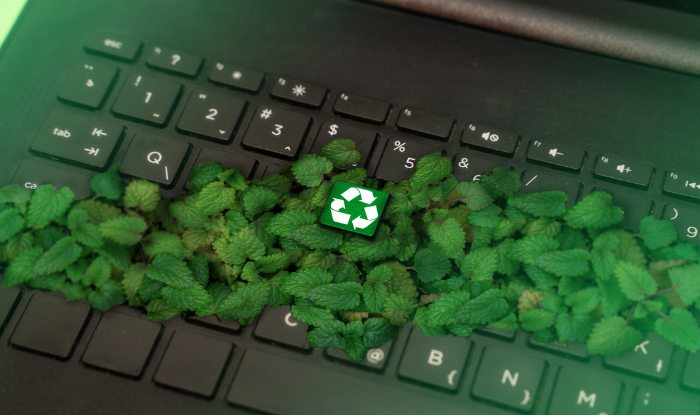
Photo Credit: iStockPhoto/Phoenixns
We live in a world where new gadgets arrive faster than we can keep up. Every year, millions of phones, laptops, and tablets are replaced, upgraded, or simply abandoned in drawers. What happens to them afterward is something most of us don’t think twice about, yet the story of electronic waste, or e-waste, is far more surprising than you might imagine.
E-waste isn’t just a pile of unwanted electronics; it’s a growing global challenge filled with hidden value, risks, and some truly eye-opening facts. From the rare metals buried inside your old phone to the startling scale of devices discarded each year, e-waste tells a story that connects technology, the environment, and everyday choices.
In this blog, we’re not here to lecture you with the usual statistics. Instead, we’ll walk you through ten fascinating bits about e-waste—facts that might just change the way you look at your gadgets. By the end, you’ll see your electronics in a whole new light.
10 Must-Know Facts That Reveal the Truth About Your Gadgets
Electronics aren’t eternal, and neither are our perspectives on them. These ten surprising facts about e-waste highlight how much value (and risk) lies hidden in that drawer of discarded gadgets. Let’s jump in.
Fact #1: E-Waste Is Ballooning—Fast
The world generated a staggering 62 million metric tons of e-waste in 2022, an 82% increase since 2010. At its current pace, global electronic waste is projected to reach 82 million tons by 2030, outpacing recycling efforts dramatically.

Why does this matter?
It’s not the weight that’s alarming; it’s that recycling efforts are failing to keep up. Just 22.3% of e-waste was properly collected and recycled in an environmentally sound way, meaning over three-quarters ended up improperly disposed of or lost entirely.
Visualize 1.55 million 40-ton trucks filled with e-waste, stretched bumper-to-bumper—that’s how massive the problem has become. With digital transformation accelerating, we’re producing waste faster than ever, and recycling needs to catch up.
Fact #2: Your Phone Might Actually Be a Mini Goldmine
A smartphone may seem trivial in value, but it packs hidden materials like gold, silver, and palladium that, when recovered in bulk, become quite lucrative. Did you know that one ton of mobile phones holds approximately 368 g of gold, 3,573 g of silver, and 287 g of palladium?

Compared to mined ore, these numbers are striking. Some estimates suggest urban mining (recovering metals from e-waste) can yield up to twenty times more gold per ton of phones than raw gold ore. That means our old gadgets are less “trash” and more “resource stash,” complete with real economic and environmental upside, if only we recycle them effectively.
Fact #3: E-Waste Harbors Toxic Substances That Threaten Health and Ecosystems
E-waste can be dangerously toxic. Discarded electronics often contain pollutants like mercury, lead, cadmium, and flame retardants, all of which pose serious risks to human health and the environment. When e-waste ends up in landfills or informal disposal sites, these chemicals can leach into groundwater, contaminate soil, and release toxic fumes that threaten both nearby communities and local wildlife.
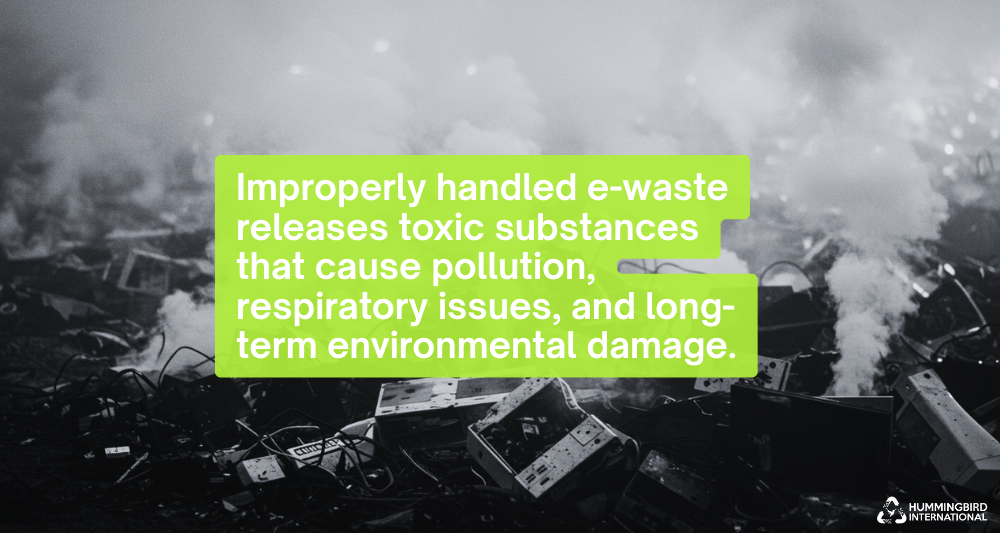
The UN’s Global E-waste Monitor 2024 emphasizes this danger, noting that these hazardous substances contribute to pollution, respiratory issues, and long-term ecological damage if not handled correctly. This is a powerful reminder that old gadgets are far more than waste; they’re a toxic legacy waiting to be managed responsibly.
Fact #4: Trillions in Valuable Metals Go Unrecovered Each Year
Here’s a startling nugget: in 2022 alone, e-waste contained about USD 91 billion worth of metal, including USD 19 billion in copper, USD 15 billion in gold, and USD 16 billion in iron. Yet, only about 22.3 % of this e-waste was formally collected and recycled, and nearly all the rest, along with its embedded value, went unrecovered.
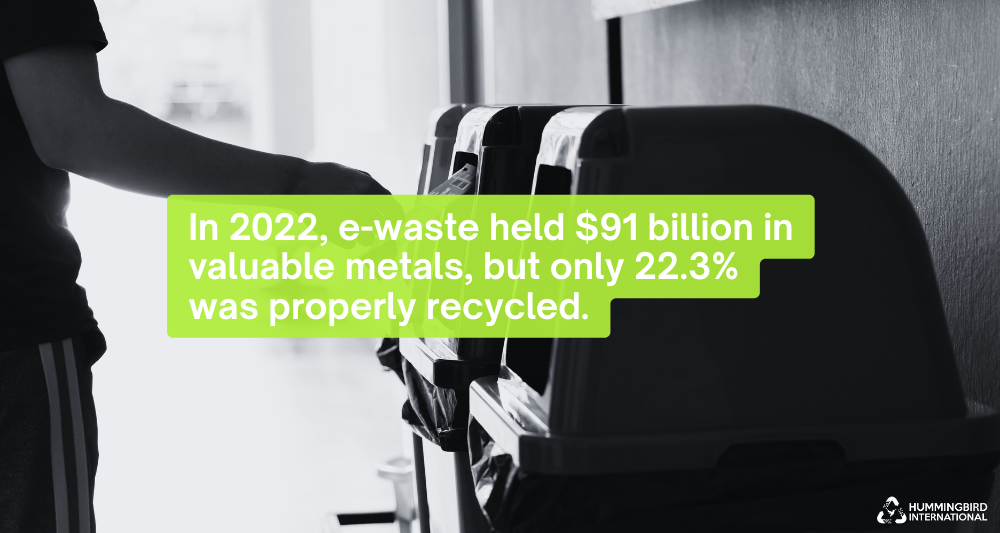
This not only represents an enormous economic loss but also maintains our dependency on mining new materials—mining that’s costly, carbon-intensive, and environmentally destructive. The same Global E-waste Monitor emphasizes the opportunity: scaling up proper collection and recycling systems could help reclaim those lost resources and close the loop toward a more circular economy.
Fact #5: Unrecycled Drives Pose Data Risks
When people toss out old laptops, desktops, or hard drives without recycling, they often forget that these devices still contain valuable data. Even if files are “deleted,” they can usually be recovered with simple software tools. That means sensitive information like personal photos, banking records, business files, or even medical histories could end up in the wrong hands. In fact, one study found that 42% of used hard drives purchased from online marketplaces still contained recoverable sensitive data. This means a discarded hard drive can be a trove for identity thieves, fraudsters, or industrial spies.
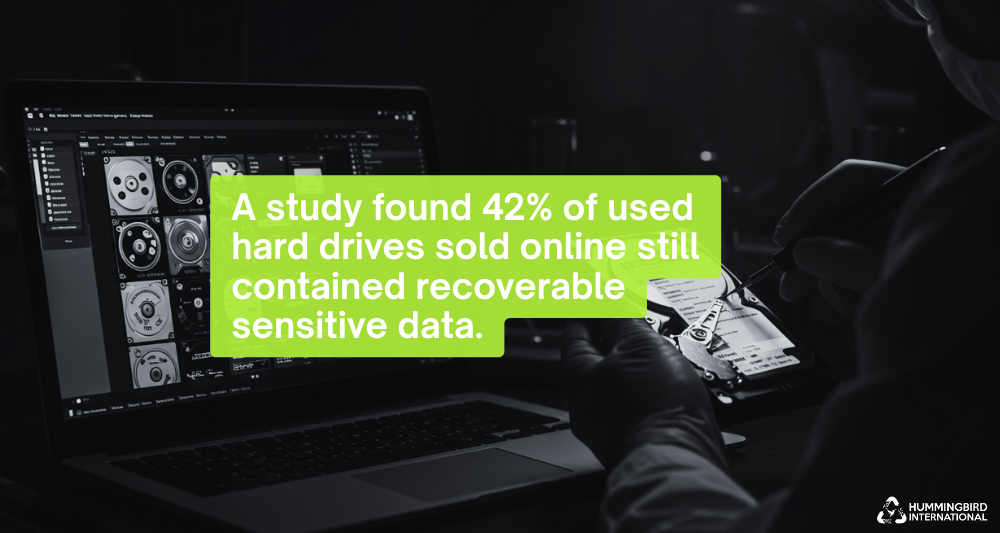
Data breaches don’t just happen online; they can occur from a discarded hard drive sitting in a landfill. Proper e-waste recycling centers use certified data destruction methods to securely wipe or shred storage devices. Without this, the risk of identity theft and fraud rises significantly. If you’ve ever upgraded your computer or smartphone, it’s crucial to ensure your old device is properly recycled and wiped clean.
Fact #6: Illegal E-Waste Dumping in Developing Nations
Not all e-waste gets processed safely, and not all countries handle e-waste responsibly. A shocking amount is shipped, sometimes illegally, from wealthier nations to developing countries. These regions often lack the infrastructure to handle toxic components safely. Instead, discarded computers, phones, and TVs are broken apart in unsafe conditions, releasing dangerous substances like lead, mercury, and cadmium into the environment. Workers, including children, are frequently exposed to these hazards while trying to extract valuable metals from the waste.

This practice has turned places in India, Nigeria, and Ghana’s Agbogbloshie into what activists call “digital dumping grounds.” Beyond health risks, this also creates environmental damage, contaminating soil and water supplies for local communities. Proper global enforcement of e-waste laws is critical to stopping this harmful cycle.
Fact #7: Recycling Rates – Less Than 20% of E-Waste Gets Recycled
Today, only about one in every five electronic devices gets recycled properly—less than 20% of global e-waste is processed in a way that’s safe and environmentally sound. The rest often ends up in landfills, incinerators, or informal recycling operations. This gap means that most of the materials tucked inside our gadgets—like precious metals and rare-earth elements—go to waste, while hazardous components quietly poison ecosystems.

In some regions, e-waste recycling rates are even lower: parts of Africa manage barely 1%, while Europe is comparatively better at around 40–42%. Until infrastructure and policy catch up with the rapid growth in electronics consumption, this figure isn’t likely to improve.
Fact #8: Repurposed Potential – E-Waste Powers Green Tech
One of the most overlooked benefits of e-waste recycling is its ability to fuel renewable energy innovation. The metals extracted from old electronics such as copper, aluminum, and rare earth elements are essential for building solar panels, wind turbines, and batteries for electric vehicles. Instead of being left to pollute landfills, these materials can help transition the world toward cleaner energy.
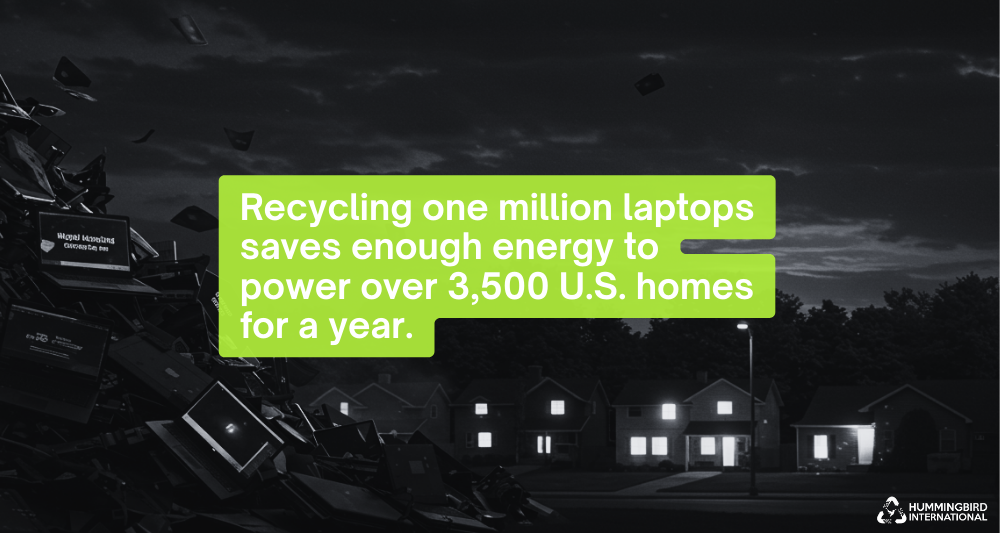
For instance, recycling one million laptops saves enough energy to power more than 3,500 US homes for a year, according to the U.S. EPA. Moreover, recovering critical materials locally reduces dependence on resource-heavy mining operations that damage ecosystems. By repurposing e-waste into renewable energy systems, societies can close the loop on resource use while supporting global climate goals.
Fact #9: Recycling Cuts Greenhouse Gas Emissions
Mining and refining raw materials for electronics is energy-intensive and emits significant greenhouse gases. Recycling e-waste reduces this burden by recovering metals and plastics for reuse, which requires far less energy than mining from scratch. For example, recycling aluminum saves 95% of the energy needed to produce it from raw materials. Similarly, recycling steel and copper can reduce emissions by 30–60%.
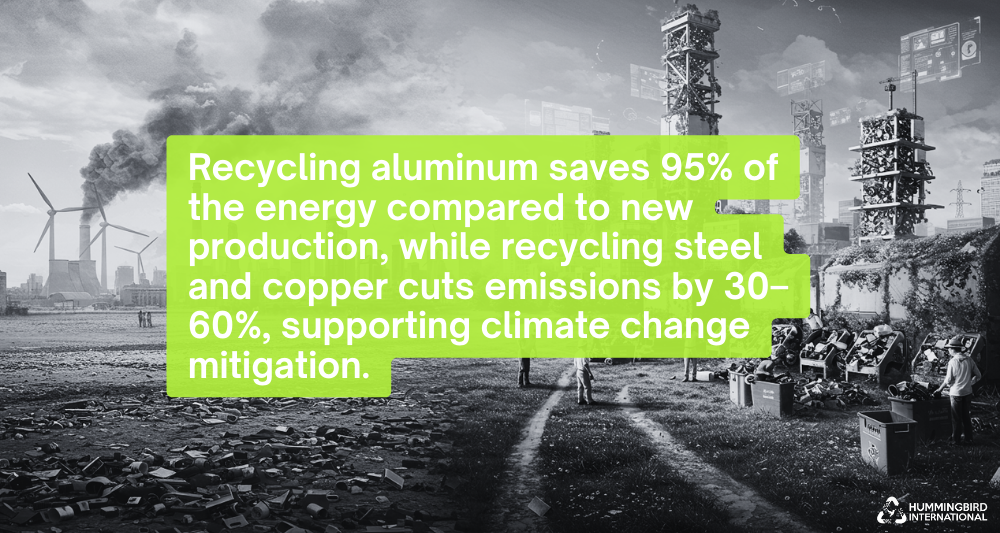
According to the UN, improving e-waste recycling can directly support climate change mitigation efforts, making it not only a waste management issue but also an environmental priority. Every smartphone, laptop, or TV properly recycled helps lower the carbon footprint of future devices. This means responsible e-waste disposal isn’t just about avoiding pollution—it’s also about reducing the emissions that drive global warming.
Fact #10: Your Role – Households Drive E-Waste Generation
It’s easy to assume big corporations generate most of the world’s electronic waste, but households play an equally large role. Old phones, chargers, laptops, and TVs pile up in homes, often forgotten in drawers or tossed in regular trash bins. According to the UN, households contribute nearly two-thirds of global e-waste, while the remainder comes from businesses and governments.
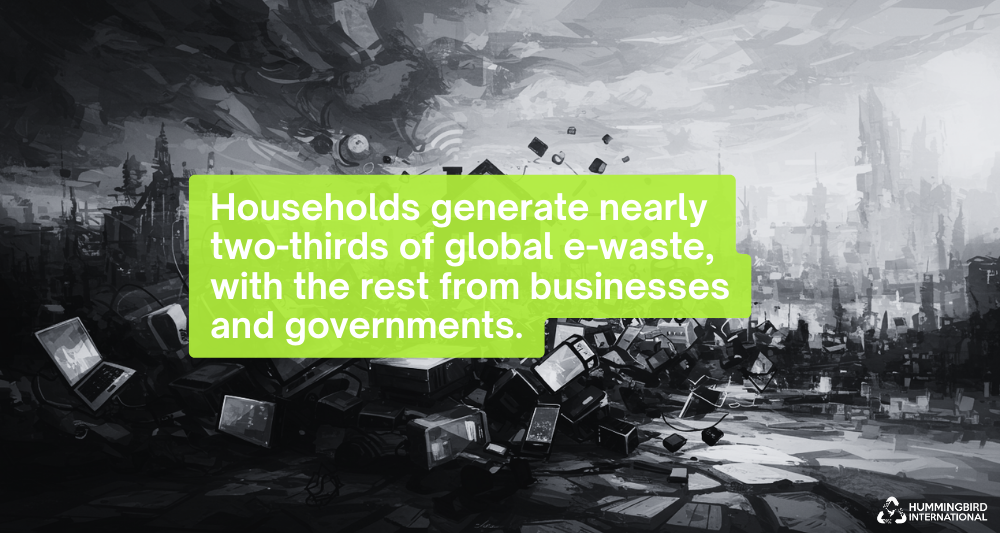
The problem is that most individuals lack awareness about safe disposal methods or access to collection centers. This makes community-based recycling programs and consumer education essential. By taking simple steps like donating working devices, returning electronics to retailers, or using certified e-waste recycling facilities, households can drastically cut down on waste. When individuals act collectively, the impact is massive.
E-Waste: A Challenge We Can All Tackle
E-waste is a growing challenge with real consequences for our environment and health. While governments and industries have a big role to play, every individual action matters too. Choosing to recycle your phone instead of tossing it in a drawer, supporting companies with sustainable practices, or even extending the life of your devices can make a noticeable difference.
Tackling e-waste may feel overwhelming, but it’s really about small, conscious choices adding up. If we treat our tech’s end-of-life with the same care we show when unboxing something new, we move a step closer to a cleaner, smarter, and more sustainable future.
About The Author Kelly Sampson
Kelly Sampson is a writer, blogger, and environmental enthusiast. She has strong opinions about climate change, the dogs vs. cats debate, and Oxford commas. She has lent Hummingbird International her engaging and spirited voice and turned our blog into a great place to find valuable information about e-waste, e-waste recycling, and the ITAD industry. Explore our blog to read more of her work.






